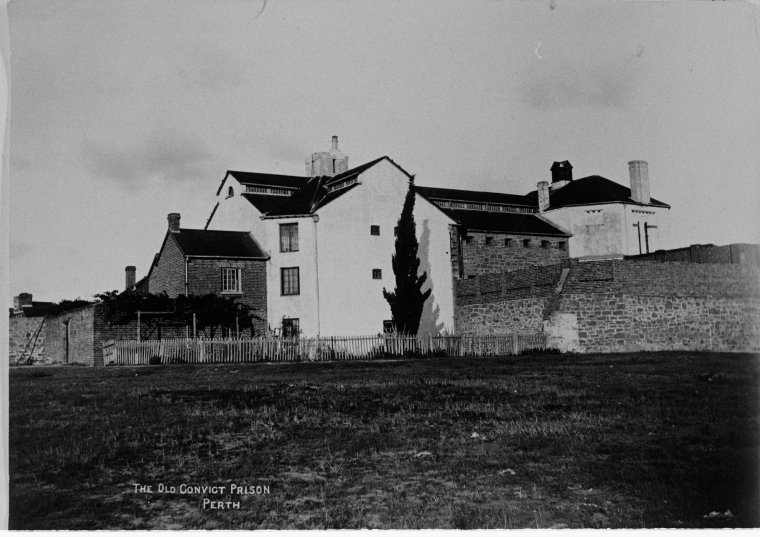Old Perth Gaol and the Western Australian Museum
Built to partially house the increasing number of convicts transported to the state, Old Perth Gaol is one of the oldest buildings in Perth, and a reminder that Western Australia was briefly a penal colony under the British Empire.
The Swan River Colony was famously Australia’s first non-penal settlement, established in 1829, although it was convict supported. Beginning in 1849, the State requested convict transportation from Britain for use as labourers to maintain Perth’s growing infrastructure needs. These new prisoners required a larger dedicated housing facility within the city itself and thus, Perth Gaol was built between 1854 and 1856.
The proposal for the gaol was approved by WA Charles Governor Fitzgerald in December of 1853, with construction to begin the next year. The location, at the intersection of Beauford and Francis Streets, was chosen for its proximity to the centre of Perth. Designed by colonial architect Richard Roach Jewell, the two story structure was built using convict labour and used limestone sourced from Fremantle. The gaol contained a basement, chapel, gaoler’s quarters, cells, and a prisoners’ yard, in which executions would take place. Prisoners would be executed here throughout the buildings life as a prison. Pictured, Perth Gaol in 1860, four years after construction was complete and the first prisoners were transferred here. (Supplied: Western Australian Museum)
The first prisoners to be incarcerated at Perth Gaol were transferred from both Fremantle Roundhouse, as well a smaller lockup within the City of Perth which was located on St Georges Terrace, where the Deanery building now sits. The construction of Perth Gaol also coincided with that of Fremantle Prison, which took much longer to complete due to its size.
Convicts transported from Britain first arrived in June 1st 1850. A total of 42 convict voyages would see 9721 prisoners shipped to Western Australia. The last of these, on board the Hougoumont, reached Fremantle on 10 January carrying 42 inmates. The cessation of convicts to Australia was strongly objected by the Colonial Government at that time.
Executions took place in the prisoners’ yard and were shielded from public view after early complaints. The vast majority of the prisoners whom were executed here were convicted for murder, with the notable exception of James Fannin, who was hanged on 14 April 1871 for rape, the last man to be put to death in Western Australia for that crime.
Throughout the 33 years that the gaol building was in use as a prison, inmate numbers steadily grew to a point were overpopulation necessitated the transfer of all prisoners to other correctional facilities around the state. At times towards the end of its use, Perth Gaol housed over 150 people.
The Gaol building temporarily found use as Perth Courthouse in 1888 as well as by various police departments when necessary. In 1891 the building was renamed the Geological Museum, then one year later, Perth Museum.
“A new gaol is to be erected in Perth, and that the Court House is to be materially altered and improved. We look upon these works as essentially necessary, and shall be glad to see them taken in hand. if judiciously planned. The deplorable state of the Perth gaol has long a vexed question, and the barn-like appearance of our Court House has also been frequently commented upon.”
Perth Gaol, 1890, two years after the last prisoner was transferred to Fremantle Prison. It was around this time that the gaol was under use as Perth Courthouse. (Supplied: State Library of Western Australia)
Perth Museum was established in the Old Gaol building in 1888. During that time the building underwent renovations with the complete removal of the interior cell block and a redesign and lowering of the roof. an additional wing was constructed later in 1895, to the north. The lowering of the roof was later reversed during further renovations between 1968 and 1976. Pictured, Perth Museum in 1951 (Supplied: State Library of Western Australia)
The size of the gaol building proved to be too small for the newly established Perth Museum, so in 1895 a new building was designed by colonial architect George Temple Poole. Built between 1897 and 1899, the Jubilee Building, named for HM Queen Victoria’s Golden Jubilee, was constructed on the north side of the James Street Mall, in front of the origiinal gaol site. The Perth Gaol building was then converted to storage for the Western Australian Museum, and remains in use in this capacity to this day. Pictured, The Jubilee Building in 1900. (Supplied: Western Australian Museum)
The Western Australian Museum was further expanded in 1913 with the completion of Hackett Hall, to the west of the Jubilee Building. Hackett Hall doubled the exhibition space for the museum and allowed for the removal of some collection pieces from the original Gaol building into displays for the public to view. Pictured, Hackett Hall in 1935, during a period of low development on the Cultural Centre site, due to the repercussions of the First World War and the Great Depression. (Supplied: State Library of Western Australia)
Western Australian Museum on 22 May 2017 as the glass insertion between Hackett Hall and the Jubilee Building is removed as part of the ongoing New Museum for Western Australia project. The Old Perth Gaol building is visible through the site in the background. The Western Australian Museum closed in 2016 during the course of the development and will reopen in 2020. (Supplied: Community News Group)








